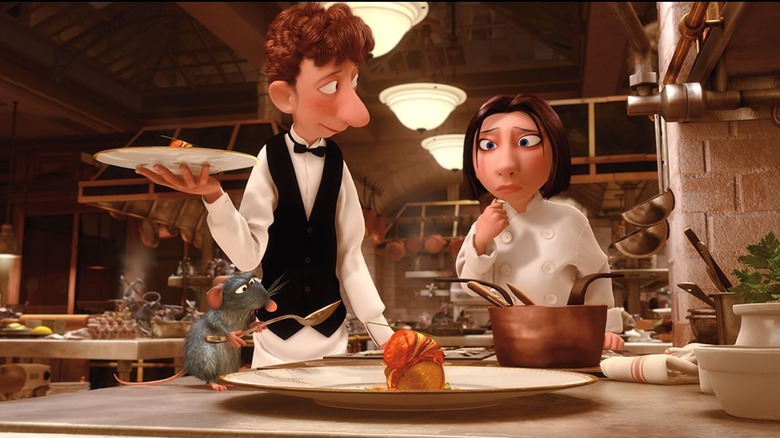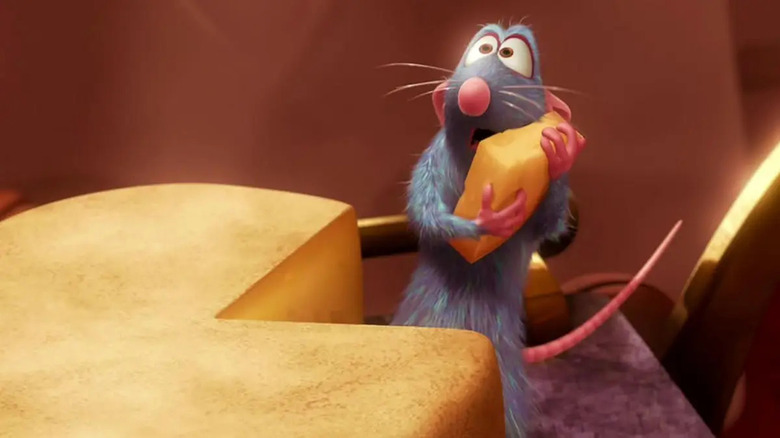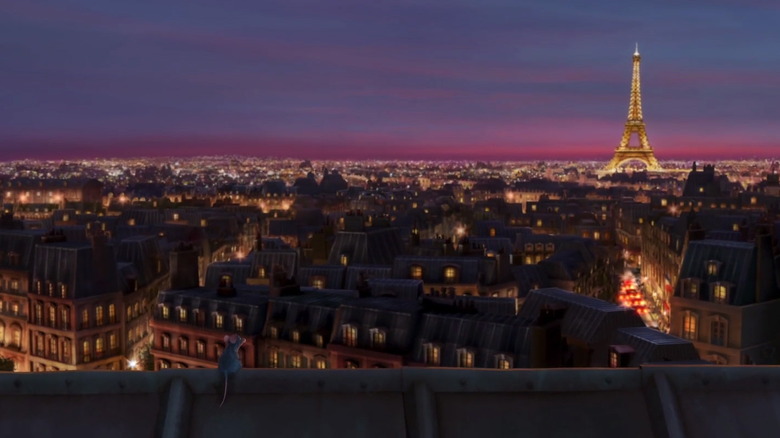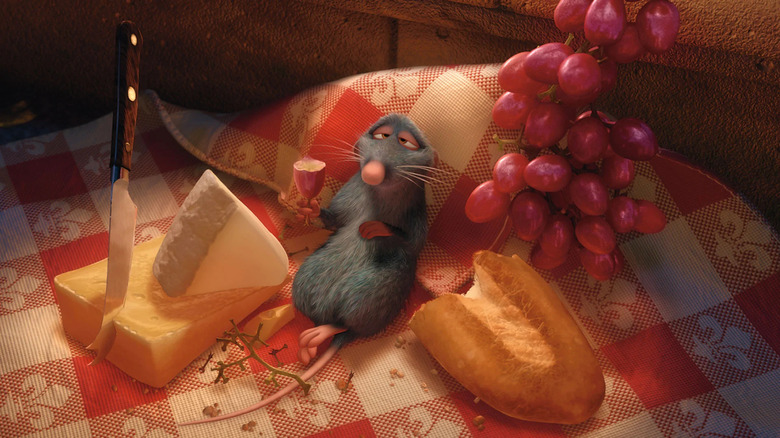Ratatouille's Paris Pushed Pixar's Animation Tech To Its Limit
With the release of "Lightyear," its twenty-sixth film to date, Pixar Animation Studios has come somewhat full circle. Virtually just as many years ago they released "Toy Story" and revolutionized the world of 3D animation. Every film they've released since then has managed to continuously wow audiences with their lifelike and beautifully animated renderings. From the ocean depths of "Finding Nemo" to the colorful cosmos explored in "WALL-E." But the feats that the animation teams at Pixar have to accomplish to create such films can often be lost in the ease with which their magic whisks us away.
Even when they manage to figure out tricky substances like water or how to recreate the gravity of space, with every new movie, the number of elements of the physical world needed to design increases. When it came to their eighth film "Ratatouille" the new mysteries to be unraveled dealt with some of the film's most crucial aspects – like accurately portraying the scale of a Parisian mouse as he makes his way through the city's sewers and places of fine dining. But there was also the question of the food Remy so eagerly desires to cook. If there was one blunder a movie about French cuisine in Paris could not make it was to animate food that looked anything but incredibly delicious.
Getting the scale right
In telling the story about the budding friendship between Linguini and Remy, "Ratatouille" effortlessly shifts between two vastly different perspectives. Take for instance the kitchen of Gusteau's Restaurant where the two characters first meet. When Remy accidentally falls into the kitchen — right into soapy sink — his experience with the landscape is dissimilar to Linguini's in every way. Apurva Shah, who worked on the animation team for "Ratatouille," told BBC that nailing the scale of Remy's perspective was critical.
"An example of scale is a sequence where Remy falls into a sink of water. From a rat's perspective, it's almost like a human falling into a pool from much higher up. We wanted to keep it at human scale but make it feel like what a rat would feel like. The speed at which things move and the details are all on a human scale but they have an imposing character of something much bigger."
As Remy moves through the kitchen everyday objects become terrifyingly colossal. You really get the sense of the kind of hostility that surrounds the life of such a small creature – which of course dovetails nicely into the larger themes in "Ratatouille." The film's opening scene, in which Remy is separated from his family by a shotgun-wielding old lady, similarly underscores just how much work went into developing the film's 3D landscape as seen by its smallest characters.
Bringing Paris to life
Apart from scale, there was also the matter of recreating the city of Paris, which presented its own hurdles. In an interview with Collider, director Brad Bird revealed that creating a polished cityscape was never the intention. "I think our goal is to get the impression of something rather than perfect photographic reality," he explained. Bird continued:
"... and Paris is a very rich city that has a lot of history to it and it's lived in. Everything's beautiful but it's lived in. It has history to it, so it has imperfections and it's part of why it's beautiful is you can feel the history in every little nook and cranny. For us every single bit of that has to be put in there. We can't go somewhere and film something. If there's a crack in there, we have to design the crack and if you noticed the tiles on the floor of the restaurant, they're not perfectly flat, they're like slightly angled differently, and they catch light differently. Somebody has to sit there and angle them all separately so we had to focus on that a lot."
Bird's comments really highlight the extensive world-building necessitated in the creation of any Pixar film. If you're rebuilding Paris from scratch and want it to look like a lived-in city, it needs to be designed that way. Making every imperfection a consciously chosen decision to present everything from an entire city to a single room in a certain way. Like the 3D landscapes of old, too much symmetry or perfection would've started to feel uncanny. All that remained was the food — and therein lay Pixar's biggest challenge yet.
Getting the cooking and food to look appetizing
One of the first difficulties Pixar faced when trying to animate the food in "Ratatouille" was making it look as mouth-watering as it would in real life. "And it was a movie about good food and the food had to look delicious and its data," Bird told Collider. "How do you define what makes food look good?" A big part of it turns out to be lighting which was the responsibility of Sharon Calahan. Speaking with BBC she elaborated:
"We spent a lot of time early on thinking about food and looking at photography, trying to analyze what made it look healthy and appealing and, in turn, what new tools and processes we needed to develop in order to do that. Apurva was wonderful in helping us to develop this new technology to make soft but accurate reflections and to make [the food] appear translucent."
But it wasn't just about making the various food items appealing to the eye. The "other big challenge," as Shah put it, was trying to accurately animate the various materials that makeup the ingredients in any given dish served at Gusteau's.
"Typically in computer graphics people deal with liquid – oceans and storms – or with solids and things blowing up or falling apart. But in cooking there are very many different kinds of materials that have a halfway quality of solids and liquids."
Take batter for instance – a substance that will look and behave very differently when whisked than water. "Even something like cracking an egg...it was important to capture that in order to make the cooking feel believable," Shah insisted. Luckily the crack team at Pixar was able to not only make the dishes in "Ratatouille" scrumptious enough to get a stamp of approval from Anthony Bourdain but also obey at least in appearances the laws of physics.



